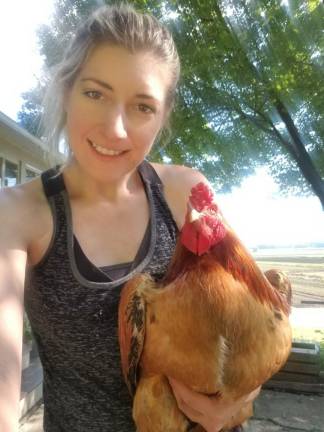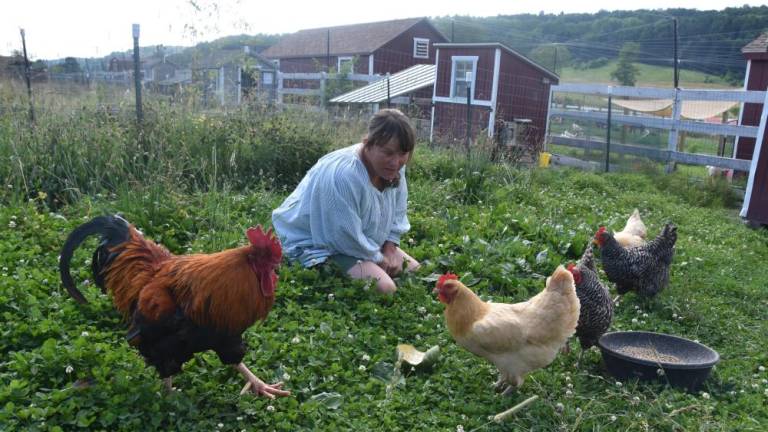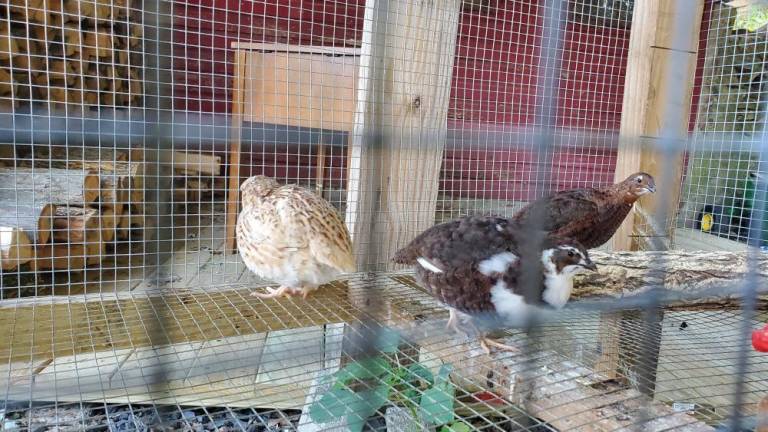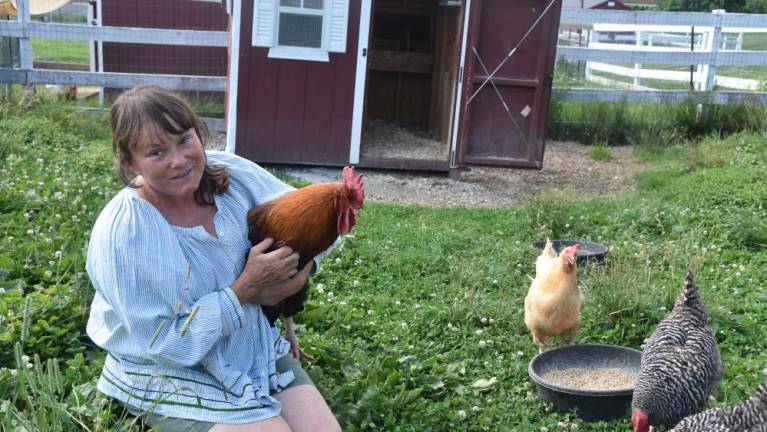Backyard poultry boom enters post-honeymoon phase
Pandemic poultry. Some chicken keepers are hooked. Others are looking to re-home their “girls.”




The storyline is familiar by now. Quarantined families flocked to keep chickens, which promised not only a supply of fresh eggs at a time when the food chain was shuddering, but also entertainment and education for homebound kids, tick control, garden fertilizer, and even emotional support.
Longtime chicken keepers seized the moment to get into quails, guinea hens or turkeys, or let their hens hatch their own eggs instead of buying them through the mail.
The last 16 months have been a boom time for backyard poultry. But as the world opens back up, some backyard flocksters – or their fed-up neighbors – are eyeing their “girls” with a more discriminating gaze. Now that those balls of fluff have turned into full-grown fowl, not to mention the surprise rooster or two you’re not actually allowed to have, the honeymoon phase is winding down fast.
Hard questions are cropping up, like: Who’s going to feed the flock when the family goes on vacation? Can I call the cops on whoever’s damn rooster keeps waking me up at 5 a.m.? And remind me who thought guinea hens sounded like a good idea?
On top of that, “the cost of feed has gone through the roof,” said Emily Shoop, a poultry educator with Penn State Extension, due largely to the rising price of corn. “For the backyard folks – maybe they got five chickens last year and then got five more, ‘cause oh they’re cute, they’re fun, they’re cuddly. Then they realize, oh but now we have to feed 10 chickens. Or 50 chickens. And that’s not really conducive to our bottom line, and we’re not making money on it anymore, so a lot of folks are either downsizing or getting out.”
The Tractor Supply impulse buy
Danielle Montuori of Florida, N.Y., who co-owns Bellezza Hair Salon with her mom, had been keeping chickens for meat and eggs for three years when she decided on impulse last April to add quails to the mix.
“I had a friend that has them, and I always thought they were neat,” said Montuori, 30. “And then when I went to Tractor Supply, the lady was telling me about the quail chicks and how they never had ‘em before. I kept thinking, why not? I already got a whole bunch of chicks running around.”
Montuori lives on an acre-and-a-half of black dirt and has a sizeable meat bird sideline. The day before we spoke, she and her boyfriend, along with one other friend, slaughtered 53 birds, which she spent the next couple days packaging and delivering to customers, many of them patrons of the salon.
“I probably got ‘em for something else to do,” she said of the bobwhite quail chicks she went home with that day, “because it was right when our hair salon shut down.”
Later, after doing some research, she ordered another kind of quail egg online – Coturnix, which are friendlier and better looking than the bobwhites, she thought. And remarkably, they take only 10 weeks to start laying eggs, compared to a hen’s five and a half months. Using an incubator, Montuori successfully hatched about half of the 30 eggs she received.
“It was kind of neat,” she said. “I got to be home watching them hatch.”
She got a kick out of making mini hard-boiled eggs, and she hatched some of the quail eggs into another generation.
“But I ended up getting rid of them around wintertime,” she said. “Because I was thinking about it: they’re outside and you have to keep the water from freezing and keep them from freezing and I just didn’t want to deal with it. The chickens are enough to deal with.” She gave the quails to a friend who hosts foxhunts on his property.
Forever homes are hard to find
An unprecedented number of people are finding themselves in a similar boat, anxious to offload animals picked up during the pandemic, from roosters to guinea pigs to Easter ducklings and bunnies to potbelly pigs. Montuori has a farm sensibility – she dreams of opening a feed and grain store one day. But many small scale flocksters consider their poultry more than livestock. They are pets in need of good homes.
“I don’t see a lot of slaughtering birds,” said Shoop, the poultry educator. “Typically the folks that I work with, their chickens are their pets, so they’re not going to dispatch them. They might take them somewhere to have them processed if they’re not so connected to them. But by and large the folks I work with are very, very emotionally connected to their birds. Which is okay. I was that way as a kid, too, when I was in 4-H.”
When it comes to re-homing chickens, there aren’t a whole lot of options. Backyard chicken keepers might sell or give their birds to a farmer, if they know one. In more rural regions, they might bring them to a livestock auction, where a chicken fetches between $5 for a spent layer destined for soup, up to $12 for a pullet just about to start laying.
“There’s always a hesitation. If I take my birds to an auction, the Amish will buy ‘em up and they’ll just slaughter them,” said Shoop of the concerns she hears. “Well, a lot of times, that is what they’re used for. You’re still using the whole bird. Yes, they are ending their lives, but they are actually going to be of use to someone, rather than just living out their days as a bird that’s just eating feed and not producing any eggs.”
‘Sorry, we’re full’
Then there’s the sanctuary, which is like heaven on earth for farm animals. But thanks to all the people looking to re-home chickens, they’re at max capacity. In addition to the perpetual influx of roosters, Tamerlaine Sanctuary & Preserve in Montague, N.J., has also taken in 20 laying hens in the past few months – typically, they don’t get hens at all. And the calls keep coming. One little boy came in crying: he didn’t want to give up his chickens, but his Bergen County home wasn’t zoned for them.
“We started our sanctuary with two roosters,” said Gabrielle Stubbert, co-founder and executive director. “We love roosters, but there’s a limit to how many you can take in, We say, ‘We’re sorry, we’re full,’” and direct people elsewhere, like the Facebook page Vegans with Chickens.
The 336-acre sanctuary houses its 150 or so rescue chickens near the infirmary because they require such a high level of care for maladies ranging from bumblefoot to broken wings. The vet bill for the chickens alone might run to $20,000 a year, estimates Stubbert. She and her husband are vegans; they hard-boil their hens’ eggs, mash them up with herbs, and feed them back to the chickens.
When people call about chickens, Stubbert tries to convince the owners to keep them, talking through what the problem is. But usually the stumbling block is intractable, like: the chickens’ purpose was to provide eggs, and they’re not laying much anymore.
Stubbert can go on and on about why chickens make wonderful pets. They’re more like humans than any other animal at the sanctuary, she thinks. They have the same social structures we do: the hen-pecked husbands, the pecking order – and, for better or worse, the same mean streak, especially when a new hen comes in.
Her spiel doesn’t usually work, admitted Stubbert. Because there are no repercussions for giving up animals, “if there’s any kind of trouble, or they’re having any kind of difficulty, they’re just like, ‘It’s too much, I don’t want them anymore,’” she said.
Dogs and cats get abandoned too, but not as frequently as poultry. Sometimes people just let their roosters go assuming, incorrectly, they can fend for themselves, Stubbert said. “It’s easier I guess mentally for people to abandon a chicken, because being an animal in our food chain, they think less of them,” she said. “We’ve been conditioned as a society to see these animals as other, not as sentient beings, and that also I think makes it easier for people to give them up.”
There is someone who’s happy about the hens getting ditched at the sanctuary. That’s Lennon the rooster, who now has a harem of four to keep him company.
A low bar to entry
“You go to Tractor Supply, they try to sell you $2 chickens,” said Dan Schwartzbeck, a wildlife management officer and owner of Got Wildlife? based in Orange County, N.Y. “It’s like the goldfish at the fair. Once you get them home it’s a different responsibility. It’s so cheap, but the overall specialty goes beyond that. It’s not something for the average Joe or Jane, in my opinion.”
Schwartzbeck has been fielding a higher percentage of calls about poultry since the pandemic began. Usually they’re from people who want to get rid of foxes or raccoons that are preying on their chickens, but occasionally the caller has had enough of the rogue chickens digging up their yard, or the rooster waking them up at the crack of dawn. “Everyone loves to hear ‘em, but not at 5 in the morning,” he said. If they’re off the owner’s property, he said, they can be dealt with as nuisance wildlife. Usually he’ll catch the chicken in question and bring it to a farm.
“I love chickens, you know,” he said. “I think they’re awesome. I like roosters too. They’re badass, some of them are beautiful, the colors on ‘em.” As for the eggs, “from a protein perspective you can’t get anything better.”
On the other hand, “they rip up your lawn, they scratch things up, there’s a lot of diseases involved,” he said. Exhibit A: the outbreak of Salmonella infections that has sickened 474 people in 46 states – a third of them children under five – hospitalized over 100 and killed one. The Centers for Disease Control and Prevention linked the outbreak to backyard chickens and ducks, making headlines with their admonition: “Don’t kiss or snuggle backyard poultry.”
Boom slows but isn’t going away
Though the backyard chicken boom has slowed, it’s far from over. “Folks that got layers in 2020 likely will need to replace those hens in 2022, so I have a feeling this is going to continue and snowball for a while,” said Shoop, the poultry educator. Her job has never been more secure, she laughs. “The more folks are exploring, they might branch out into ducks or turkeys.”
The larger pet industry is exploding, because more people are getting pets and also because they’re spending more on them per capita. Morgan Stanley predicts the $100 billion industry will nearly triple in size in the next decade, and feathered friends appear to be trending right along with the fur-babies. The country living chain Tractor Supply, which sold a record 11 million chicks last year – half of them to new customers – has announced the opening of 80 new stores. The boom is driven largely by the diaspora of city folk to the suburbs, the kind who might buy a $1,900 chicken coop along with their 15 chicks.
“I think everybody should have a flock of chickens in their backyard,” said Shoop, the poultry educator. The poultry boom is the best thing to come out of the pandemic, in her eyes. “I would like to see this continue, I just would like to see folks have a little more forethought.”
Shoop helped write new ordinances in the past few months for townships just starting to allow chicken keeping, which include guidelines for manure management and the disposal of dead birds, things you might not otherwise think about until they become a problem. “A lot of folks this year have gotten fined or pulled into township meetings,” she said, for breaking rules they didn’t know existed.
Web-branding entrepreneur Kate Algera started the Facebook page Warwick NY Backyard Chickens last February in preparation for getting her first chicks. The page now has 125 members whose posts run the gamut from weird-looking eggs to whether to trim wing feathers to the perennial problem of roosters and drakes in need of homes.
“Raising chickens was something I had in the back of my mind for a while,” said Algera. During the pandemic, she and her husband moved from Greenwood Lake to Warwick to settle into a more long-term home. Their new property was already set up for chickens, “so that’s what drove the idea of chicken-keeping higher up on my dream list!” she said. The fact that she’d recently started working from home and would be able to check up on her flock throughout the day was key in her decision to pull the trigger.
She hasn’t regretted that decision at all, she said, although she didn’t anticipate how often six chickens would occupy her thoughts. “Like when I realized my six pullets were actually two roos and four pullets, slowly training/introducing my dog to them, dealing with this current heat,” she said. “But that stress is because these are all new scenarios. Hopefully as I go through the seasons with chickens, I’ll better understand the flow of how to keep them thriving and won’t be wondering about it all as I’ll have experience to lean on.”
“For the backyard folks – maybe they got five chickens last year and then got five more, ‘cause oh they’re cute, they’re fun, they’re cuddly. Then they realize, oh but now we have to feed 10 chickens. Or 50 chickens. So a lot of folks are either downsizing or getting out.” Emily Shoop, Penn State Extension